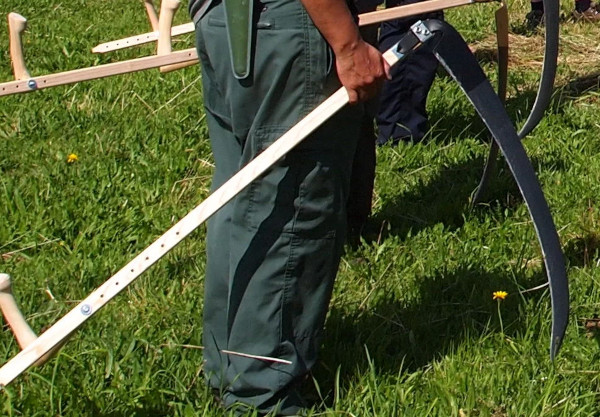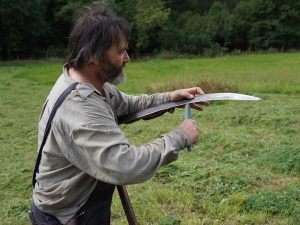Part 1 was about your lawn; Part 2 is about your scythe and blade; and Part 3 about scything techniques for short grass. With a bit of practice, you don’t really need the plastic, resource use, electricity and noise involved with lawn-mowers.
We’re often asked if it is possible to mow a lawn with a scythe. The answer is yes and there are many people in the UK doing just that! Lawn mowing can be a test of a scythers skill, it takes some thought and practice to do well. Here is a summary of the factors you need to consider if you are thinking of scything a lawn.
You don’t have to have a specific “lawn mowing” scythe blade. Most grass blades will manage lawn mowing if well peened and sharpened (see further on).
Below we consider how to choose a compromise blade that can manage a wider range of mowing.

What makes a nice lawn blade?
Lawn mowing blades need to be able to hold a fine, gradually tapering edge. A Fux Bush Blade is just not going to do it!
A curved belly to the blade (as found in the Falci blades and the Profisense) gives the mower more control over the lay of the blade. (What is the lay?) By lifting or lowering the hands, the mower can “roll” the blade on it’s belly and lower or raise the lay as needed whilst mowing.
An upturn to the tip of the blade can help it ride more easily over uneven ground. Most of the blades we stock have this to a degree. It is more pronounced in the Falci 128 than the Falci 100.
A lighter finer blade is likely to need less peening to maintain a good lawn mowing edge than a heavier one.
Making your choice
Over the years we have built up a large collection of scythe blades, so have the luxury of a large choice! Many people will be content with one or two blades, selected carefully to cover their mowing needs.
When choosing a blade, look at the range of mowing you will do and make a compromise on length and weight of blade. A blade such as a Luxor, a Rasierschnitt or a Styria can be used to mow rougher weeds but still be peened up to mow a lawn.
There is a limit to have far you can stretch one blade though. It is a lot of work to peen a fine edge onto a blade that has been used to bash large areas of mature brambles! And if you try to use a fine edged blade on such vegetation you will just damage it.
Our blade choices

- We use our longest blades to mow the barn lawn and vehicle-wide grass tracks. Typically a Luxor 85cm or Rasierschnitt 95cm.
- Smaller areas of lawn and grass paths around 6ft wide are typically mown with a 75cm blade, either a Luxor, a Falci 100 or a Profisense.
- Narrow grass paths less then 4ft wide and grassy edges to brick paths are mown with a 50cm blade, either a Luxor or Falci 100.
- Paths that are 4ft-6ft wide might suit a 60-65cm blade better.
Fine Falci blades
The Falci meadow blades are a good choice, especially if your lawn is pretty tidy and free of large stones or other hidden obstacles. They are generally finer then the equivalent Fux blade and keep a fine lawn edge for longer between peenings.
Suitable blades are the Falci 128 and the Falci 100.
Grass blades from Fux
The Profisense, Luxor or Rasierscnitt blades from Fux all make good lawn blades. They are a better choice if your lawn is stony or full of toy cars!
The Luxor and Rasierscnitt make good compromise blades, able to handle rougher weeds eg bramble shoots, docks, or bracken shoots that may be creeping into lawn edges.

The Long and the short
As you only carry fairly light amounts of cuttings across each scythe stroke it is easy to use a long blade (70cm or greater) for lawn mowing.
Small lawns, narrow paths or lawns that have a number of trees / bushes to mow around suit shorter blades (60cm or less).
Compromise blades – examples
Phil will sometimes choose a compromise blade so that he does not need to switch blades whilst mowing.
When mowing a friend’s extensive lawn / meadow / forest garden he will use a 75cm blade. It is long enough to get the mowing done quickly, and whilst a little trickier around the trees it is still perfectly ok for the work.
In another garden that has a lot of narrow paths he uses a 50cm blade. It’s a bit slower on the areas of lawn, but it gets the job done!
In areas of our garden, the mowing is mainly grass but the edges contain young brambles, bracken or dock creeping in from the edges. This is better suited to a Luxor blade rather then a lighter blade like the Falci 100.
Keeping it sharp
Shorter grass has more tendency to bend away from a blade that is not very sharp. Frequent use of a sharpening stone whilst mowing and regular peening is needed for an ideal lawn mowing blade edge.

Honing
Sharpening the blade with a stone (honing) whilst out mowing needs to be done frequently. It’s hard to say how often we hone the blade, it’s much more about feel.
As soon as the blade isn’t cutting as well, we get out the stone and quickly run it over the edge. It is probably every five minutes or less. It’s quick to do and makes a great difference to your mowing. Hitting a tusky bit of grass can be enough to just take the edge off and justify a quick pass with the stone!
Honing needs to be accurate. If you stop to sharpen and find that it hasn’t made much difference, or even made it worse, you may not have managed to catch the edge properly with the stone.
Take your time and make sure you place the stone accurately. Aim to keep the angle of the stone shallow on a finely peened edge so that you don’t round it off.
More information on honing coming soon (and see here).
Use a fine stone to hone your blade. A coarse stone will wear away your nice fine edge too quickly!
A La Saurat stone is good. Beginners find it easier to use and the harshness of it’s honing can be altered by how hard you press. The Rozutec is a lovely fine stone but takes a bit more practice to use well.
Peening
Peening is the art of cold hammering the edge of a scythe blade to draw it out and restore the ideal cutting profile. If you need some background on peening, see here.
A fine, gently tapering edge is needed for lawn mowing. To test if your edge is fine enough, you can use the “thumb test”. A fine edge will “ripple” when run on the back of a thumbnail, as demonstrated in this video from Bladerunners (left)
It is fairly easy to achieve such an edge with the Fux Deluxe Peening Jig or, once practiced, by freehand peening with an anvil. It is possible with the Standard Jig too, although not so easy. Many mowers begin by using a jig. If you want to move towards free hand peening, use the jig first to establish the bevel, then freehand peen the edge.
It is easiest to achieve a good edge with a blade that is frequently peened. Sometimes, a quick edge peen is all that is needed to finesse up an existing edge.
Multiple passes with the jig or the anvil might be needed to get a heavily worked, thickened edge back into a good profile. This can be hard work, as peening work-hardens the edge making each subsequent pass a bit more difficult.




3 Comments
Some terrific advice here, makes my amateur attempts look fairly pathetic – there again I only normally “do” the grass patch at the back (I won’t call it a lawn – that’s to much of an insult to those of us who have decent lawns – but the principal is the same) about four to five times a year so the chance of becoming an expert are pretty rare – but this article points me in the right direction. Oh yes to add to the fun I keep my scythe in the lounge – tis a great conversation piece!
The Walrus
Yeah, if you’re going to have a scythe, you may as well hang it on the living room wall! Good luck.
Thanks Dave! Works for me, if all else fails it gets people talking and thinking about it – sort of reverse advertising – if it gets people interested it’s doing it’s job – reducing that fossilised fuel dependancy a bit!